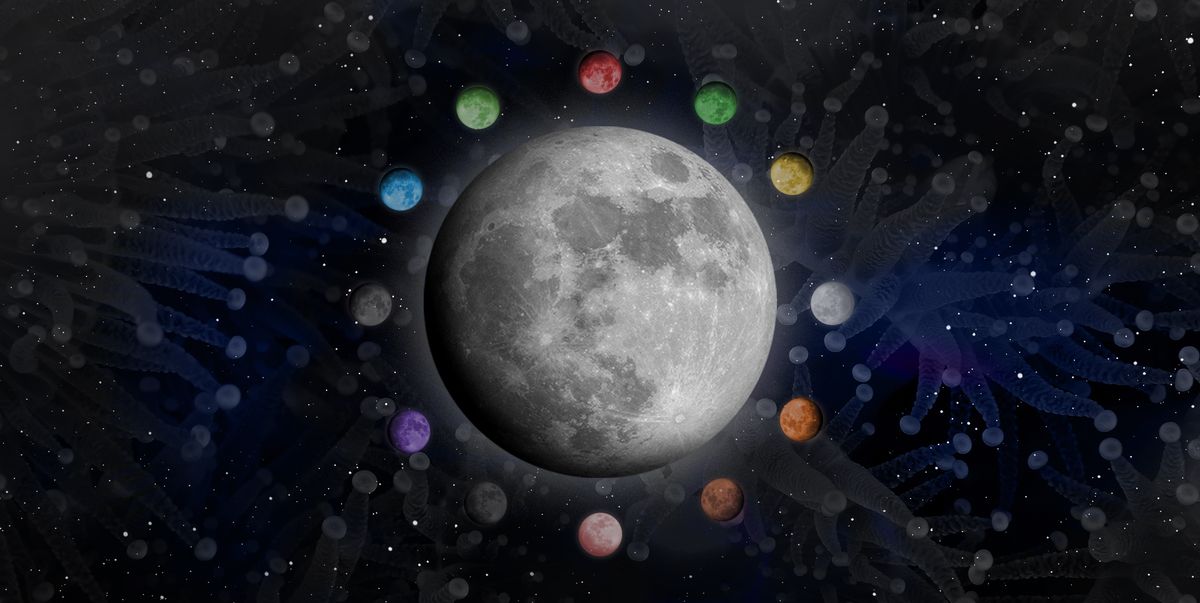Horoscope
Mark your calendar: Here are all the full moons of 2024

Grab your calendars, because there’s an important monthly event you need to know about— and I’m not talking about rent day. I’m talking about something much more vibe-y: The Full Moon. Whether you’re planning a romantic date night or getting witchy with a manifestation ritual, it’s nice to know when the Full Moon is coming so you can mark it (or not) in your own way.
First, let’s talk about what a Full Moon is. Put on your astronomy hat for a moment! A Full Moon occurs when the Moon is exactly opposite the Sun in its rotation around the Earth, appearing fully illuminated from our POV here on Earth. In contrast, a New Moon occurs when the Moon is between the Earth and the Sun in its orbit. During a New Moon, the Earth casts a shadow across the face of the Moon, making it appear fully darkened from our POV on Earth.
A full lunar cycle lasts 29.5 days, meaning that most months have one Full Moon. However, occasionally a month will have two Full Moons, with the first Full Moon occurring on the 1st or 2nd of the month and the second Full Moon occurring on the 30th or 31st of the month. This is called a ~Blue Moon~ (and why the saying ‘once in a Blue Moon’ means that something happens rarely.)
If you’re wondering, ‘When is the next Full Moon?’ we gotchu! Below, find a Full Moon calendar, traditional names for each Full Moon, and why Full Moons are so important in astrology.
Full Moon calendar for 2024
Here are all the Full Moons for 2024.
- 25th January, 2024
- 24th February, 2024
- 25th March, 2024
- 23rd April, 2024
- 23rd May, 2024
- 21 June, 2024
- 21 July, 2024
- 19 August, 2024
- 17 September, 2024
- 17 October, 2024
- 15 November, 2024
- 15 December, 2024
Full Moon zodiac signs
Generally, a Full Moon occurs in each of the 12 zodiac signs once a year. However, on some occasions, a Full Moon can occur in one of the zodiac signs twice. This is because each zodiac season is 30 days long, while the lunar cycle is slightly shorter at 29.5 days long. This means that if a Full Moon happens on the first or second day of a zodiac season, it can also happen on the last day of a zodiac season.
For example: A Full Moon in Capricorn occurs on the second day of Cancer season, on 21st June, 2024, and then another Full Moon in Capricorn occurs on the last day of Cancer season, on 21st July, 2024.
A Full Moon always occurs in the opposite sign of the Sun, because the Sun and the Moon are exactly opposite each other during the Full Moon. This means that each astrological season has a Full Moon in its sister sign. Sound complicated? Let me make it clear:
- When the Sun is in Aries, the Full Moon is in Libra
- When the Sun is in Taurus, the Full Moon is in Scorpio
- When the Sun is in Gemini, the Full Moon is in Sagittarius
- When the Sun is in Cancer, the Full Moon is in Capricorn
- When the Sun is in Leo, the Full Moon is in Aquarius
- When the Sun is in Virgo, the Full Moon is in Pisces
- When the Sun is in Libra, the Full Moon is in Aries
- When the Sun is in Scorpio, the Full Moon is in Taurus
- When the Sun is in Sagittarius, the Full Moon is in Gemini
- When the Sun is in Capricorn, the Full Moon is in Cancer
- When the Sun is in Aquarius, the Full Moon is in Leo
- When the Sun is in Pisces, the Full Moon is in Virgo
As for the Full Moons in 2024, here ya go:
- 25th January, 2024 — Full Moon in Leo
- 24th February, 2024 — Full Moon in Virgo
- 25th March, 2024 — Full Moon in Libra (also a lunar eclipse)
- 23rd April, 2024 — Full Moon in Scorpio
- 23rd May, 2024 — Full Moon in Sagittarius
- 21 June, 2024 — Full Moon in Capricorn
- 21 July, 2024 — Full Moon in Capricorn
- 19 August, 2024 — Full Moon in Aquarius
- 17 September, 2024 — Full Moon in Pisces (also a lunar eclipse)
- 17 October, 2024 — Full Moon in Aries
- 15 November, 2024 — Full Moon in Taurus
- 15 December, 2024 — Full Moon in Gemini
Full Moon names
If you’ve ever heard people talking about a ‘Pink Moon’ or a ‘Wolf Moon,’ they’re like referring to the Old Farmer’s Almanac’s names for the Full Moon. In the United States, the Old Farmer’s Almanac gives the Full Moon of each month an official name, and provides alternate names as well. Publishing guides to Moon names became popularised among various almanacs in the mid-1900s, and the Old Farmer’s Almanac began publishing its guides to Moon names in the 1950s.
Today, the Old Farmer’s Almanac includes a note that these names come from ‘Native American, Colonial American, or other traditional North American sources passed down through generations.’ For example, the name ‘Wolf Moon’ is thought to have been brought to North America by English settlers, and the name ‘Flower Moon’ has Algonquin origins.
Here are each of the Old Farmer’s Almanac names for the Full Moons:
- January: Full Wolf Moon
- February: Full Snow Moon
- March: Full Worm Moon
- April: Full Pink Moon
- May: Full Flower Moon
- June: Full Strawberry Moon
- July: Full Buck Moon
- August: Full Sturgeon Moon
- September: Full Harvest Moon
- October: Full Hunter’s Moon
- November: Full Beaver Moon
- December: Full Cold Moon
And here are other traditional names for each Full Moon, via the Old Farmer’s Almanac:
- January: Canada Goose Moon (Tlingit), Center Moon (Assiniboine), Cold Moon (Cree), Freeze Up Moon (Algonquin), Frost Exploding Moon (Cree), Great Moon (Cree), Greetings Moon (Western Abenaki), Hard Moon (Dakota), Severe Moon (Dakota), Spirit Moon (Ojibwe)
- February: Bald Eagle Moon (Cree), Bear Moon (Ojibwe), Black Bear Moon (Tlingit), Bony Moon (Cherokee), Eagle Moon (Cree), Goose Moon (Haida), Groundhog Moon (Algonquin), Hungry Moon (Cherokee), Raccoon Moon (Dakota)
- March: Crow Comes Back Moon (Northern Ojibwe), Eagle Moon (Cree), Goose Moon (Algonquin, Cree), Snow Crust Moon (Anishinaabe), Sore Eyes Moon (Dakota, Lakota, Assiniboine), Sugar Moon (Ojibwe), Wind Strong Moon (Pueblo)
- April: Breaking Ice Moon (Algonquin), Broken Snowshoe Moon (Anishinaabe), Budding Moon of Plants and Shrubs (Tlingit), Frog Moon (Cree), Moon of the Red Grass Appearing (Oglala), Moon When the Ducks Come Back (Lakota), Moon When the Geese Lay Eggs (Dakota), Moon When the Streams are Again Navigable (Dakota), Sucker Moon (Anishinaabe), Sugar Maker Moon (Western Abenaki)
- May: Budding Moon (Cree), Egg Laying Moon (Cree), Frog Moon (Cree), Leaf Budding Moon (Cree), Planting Moon (Dakota, Lakota), Moon of Shedding Ponies (Oglala)
- June: Berries Ripen Moon (Haida), Birth Moon (Tlingit), Blooming Moon (Anishinaabe), Egg Laying Moon (Cree), Hatching Moon (Cree), Green Corn Moon (Cherokee), Hot Moon, Hoer Moon (Western Abenaki)
- July: Berry Moon (Anishinaabe), Feather Moulting Moon (Cree), Halfway Summer Moon (Anishinaabe), Month of the Ripe Corn Moon (Cherokee), Moon When the Chokecherries are Ripe (Dakota), Raspberry Moon (Algonquin, Ojibwe), Salmon Moon (Tlingit), Thunder Moon (Western Abenaki)
- August: Black Cherries Moon (Assiniboine), Corn Moon (Algonquin, Ojibwe), Flying Up Moon (Cree), Harvest Moon (Dakota), Mountain Shadows Moon (Tlingit), Ricing Moon (Anishinaabe)
- September: Autumn Moon (Cree), Child Moon (Tlingit), Corn Harvest Moon (Dakota), Corn Maker Moon (Western Abenaki), Falling Leaves Moon (Ojibwe), Harvest Moon, Leaves Turning Moon (Anishinaabe), Mating Moon (Cree), Moon of Brown Leaves (Lakota), Moon When the Rice is Laid Up to Dry (Dakota), Rutting Moon (Cree), Yellow Leaf Moon (Assiniboine)
- October: Drying Rice Moon (Dakota), Falling Leaves Moon (Anishinaabe), Freezing Moon (Ojibwe), Ice Moon (Haida), Migrating Moon (Cree)
- November: Deer Rutting Moon (Dakota, Lakota), Digging/Scratching Moon (Tlingit), Freezing Moon (Anishinaabe), Frost Moon (Cree, Assiniboine), Whitefish Moon (Algonquin)
- December: Drift Clearing Moon (Cree), Frost Exploding Trees Moon (Cree), Hoar Frost Moon (Cree), Little Spirit Moon (Anishinaabe), Long Night Moon (Mohican), Mid-winter Moon (Lakota, Northern Ojibwe), Moon of the Popping Trees (Oglala), Moon When the Deer Shed Their Antlers (Dakota), Snow Moon (Haida, Cherokee), Winter Maker Moon (Western Abenaki)
What Full Moons mean in astrology
In astrology, a Full Moon represents a moment of culmination or letting go. If you’ve been working towards a goal, this may be when you finally meet it; if you’ve been considering breaking up with someone, this might be when do so. Full Moons are also a time when passions are heightened. If you’ve been flirting with someone, you may finally confess your feelings; if tensions have been brewing in your relationship, you may find yourself having a big argument. Finally, Full Moons are a time when secrets come to light. Nothing can stay hidden under the glow of a Full Moon!
What to do during a Full Moon
If you have a manifestation practice or dabble in witchcraft, Full Moons are a particularly powerful time. Here are some of things you might choose to do under a Full Moon:
Make Full Moon water
To make Full Moon water, simply leave water out under a Full Moon overnight (preferably outside, or near a window). When it’s charged, you can use it to add an extra ~oomph~ to your future rituals.
Write in a Moon journal
When you keep a Moon journal, you align what you write about with the phases of the Moon. The Full Moon is a perfect time to practice gratitude, reflect on what’s happened over the past month, or go deep and practice shadow work — looking at the darkest side of yourself that you’re sometimes scared to acknowledge.
Take a Full Moon bath
A Full Moon bath is a special kind of bath. As you soak in the water, imagine yourself releasing negative thoughts, stress, bad vibes, etc. and soaking up abundance and positivity. Design your own Moon bath by choosing herbs, essential oils, and crystals that align with the sign the Moon is in or whatever qualities you wish to absorb.
Charge your crystals
You can charge your crystals by leaving them out to soak up the moonlight overnight. Like making Full Moon water, it’s best to do this either outdoors or near a window. After you’ve charged your crystals, they’ll be at their most powerful.
Host a Full Moon circle
Gather a group of friends (or just fellow Moon lovers) to celebrate the Full Moon. Full Moon circles are very individualised. You might participate in meditation or yoga, journal together, join together in a group ritual, or simply spend time together and talk.
Practice magick
Full Moons are a powerful time to practice magick. If you’re interested in candle magick, sex magick, or any other kind of witchcraft, this is an aligned time to perform a ritual.










